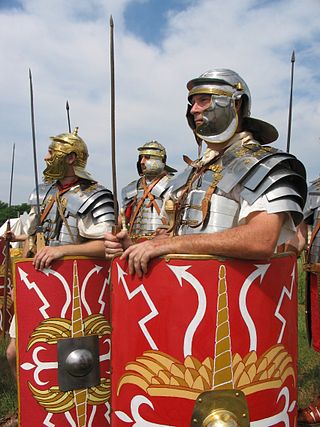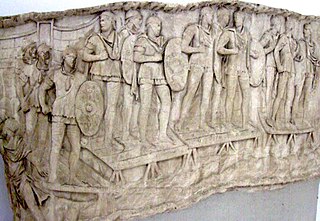The Roman legion, the largest military unit of the Roman army, was composed of Roman citizens serving as legionaries. During the Roman Republic the manipular legion comprised 4,200 infantry and 300 cavalry. After the Marian reforms in 107 BC the legions were formed of 5,200 men and were restructured around 10 cohorts, the first cohort being double strength. This structure persisted throughout the Principate and middle Empire, before further changes in the fourth century resulted in new formations of around 1,000 men.

Military ranks are a system of hierarchical relationships, within armed forces, police, intelligence agencies or other institutions organized along military lines. The military rank system defines dominance, authority, and responsibility in a military hierarchy. It incorporates the principles of exercising power and authority into the military chain of command—the succession of commanders superior to subordinates through which command is exercised. The military chain of command constructs an important component for organized collective action.

The Praetorian Guard was an elite unit of the Imperial Roman army that served as personal bodyguards and intelligence agents for the Roman emperors.

The Roman legionary was a citizen soldier of the Roman army. These soldiers would conquer and defend the territories of ancient Rome during the late Republic and Principate eras, alongside auxiliary and cavalry detachments. At its height, Roman legionaries were viewed as the foremost fighting force in the Roman world, with commentators such as Vegetius praising their fighting effectiveness centuries after the classical Roman legionary disappeared.
A cohort was a standard tactical military unit of a Roman legion. Although the standard size changed with time and situation, it was generally composed of 480 soldiers. A cohort is considered to be the equivalent of a modern military battalion. The cohort replaced the maniple. From the late second century BC and until the middle of the third century AD, ten cohorts made up a legion. Cohorts were named "first cohort", "second cohort", etc. The first cohort consisted of experienced legionaries, while the legionaries in the tenth cohort were less experienced.
The equites constituted the second of the property-based classes of ancient Rome, ranking below the senatorial class. A member of the equestrian order was known as an eques.

The Roman army was the armed forces deployed by the Romans throughout the duration of Ancient Rome, from the Roman Kingdom to the Roman Republic and the Roman Empire, and its medieval continuation, the Eastern Roman Empire. It is thus a term that may span approximately 2,206 years, during which the Roman armed forces underwent numerous permutations in size, composition, organisation, equipment and tactics, while conserving a core of lasting traditions.

In the Roman army during classical antiquity, a centurion, was a commander, nominally of a century, a military unit originally consisting of 100 legionaries. The size of the century changed over time, and from the first century BC through most of the imperial era was reduced to 80 men.
A military tribune was an officer of the Roman army who ranked below the legate and above the centurion. Young men of Equestrian rank often served as military tribune as a stepping stone to the Senate. The tribunus militum should not be confused with the elected political office of tribune of the people (tribunus plebis) nor with that of tribunus militum consulari potestate.
Centuria is a Latin term denoting military units originally consisting of 100 men. The size of the centuria changed over time, and from the first century BC through most of the imperial era the standard size of a centuria was 100 men. By the time of Roman Empire, ordo became a synonym of centuria.

An optio, was a position in a centuria (century) of a Roman army similar to that of an executive officer. The main function of an optio was as an optio centuriae, the second-in-command of a century, although there were many other roles an optio could adopt.

The primus pilus or primipilus was the senior centurion of the first cohort in a Roman legion, a formation of five double-strength centuries of 160 men each; he was a career soldier and advisor to the legate. The primus pilus would remain in command for one year. They could continue to serve in the army after their term ended if there was a vacancy in command or if they wished to become an independent commander of an auxilia unit or the praefectus castrorum.

The auxilia were introduced as non-citizen troops attached to the citizen legions by Augustus after his reorganisation of the Imperial Roman army from 27 BC. By the 2nd century, the Auxilia contained the same number of infantry as the legions and, in addition, provided almost all of the Roman army's cavalry and more specialised troops. The auxilia thus represented three-fifths of Rome's regular land forces at that time. Like their legionary counterparts, auxiliary recruits were mostly volunteers, not conscripts.
In the Roman army of the late Republic and the Principate, the tribunus laticlavius was one of the six military tribunes in a legion. Usually, it consisted of young men around age 20 who belonged to a wealthy family or were friends with the legate. The position of tribunus laticlavius was the first step on the Cursus honorum. Tribunus laticlavius are typically depicted wearing a purple cloak.
Protector Augusti Nostri was a title given to individual officers of the Roman army as a mark of their devotion to and approval by the Emperor himself. The term first appears with this meaning in the joint-reign of Valerian and Gallienus. Lucius Petronius Taurus Volusianus was the first recorded Protector appointed by Gallienus.
A turma, was a cavalry unit in the Roman army of the Republic and Empire. In the Byzantine Empire, it became applied to the larger, regiment-sized military-administrative divisions of a thema. The word is often translated as "squadron" but so is the term ala, a unit that was made up of several turmae.

The Roman army of the mid-Republic, also called the manipular Roman army or the Polybian army, refers to the armed forces deployed by the mid-Roman Republic, from the end of the Samnite Wars to the end of the Social War. The first phase of this army, in its manipular structure, is described in detail in the Histories of the ancient Greek historian Polybius, writing before 146 BC.

The Imperial Roman Army was the military land force of the Roman Empire from 27 BC to 476 AD, and the final incarnation in the long history of the Roman army. This period is sometimes split into the Principate and the Dominate (284–476) periods.
Roman infantry tactics are the theoretical and historical deployment, formation, and manoeuvres of the Roman infantry from the start of the Roman Republic to the fall of the Western Roman Empire. The focus below is primarily on Roman tactics: the "how" of their approach to battle, and how it stacked up against a variety of opponents over time. It does not attempt detailed coverage of things like army structure or equipment. Various battles are summarized to illustrate Roman methods with links to detailed articles on individual encounters.
Traianus Mucianus was a Roman soldier of Thracian origins of the second half of the Third Century AD who rose from the lowest ranks of the army to senior commands. He was almost certainly a remarkable soldier. However, the successive promotions he secured in the latter part of his career are thought to owe much also to the favour shown him by men highly placed in the Imperial entourage whose patronage secured him advantageous postings in the Imperial comitatus, the mobile field force under the direct command of the Emperor, that was undergoing massive expansion at this time.










